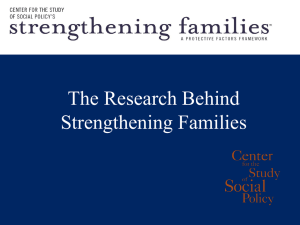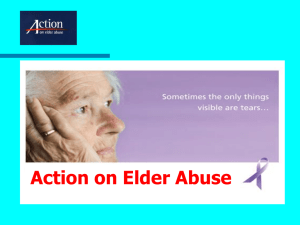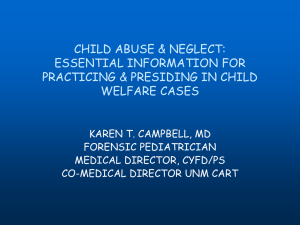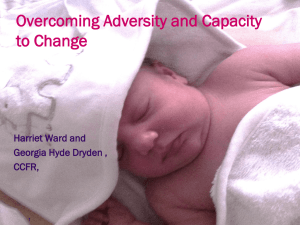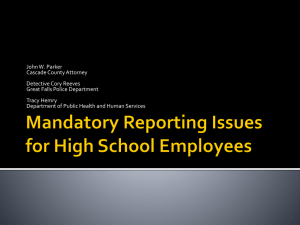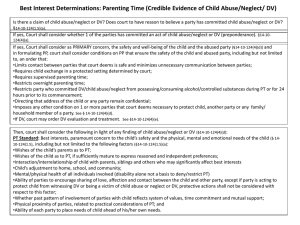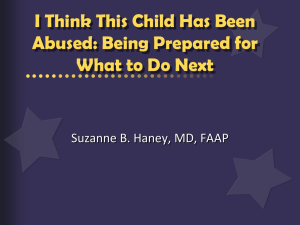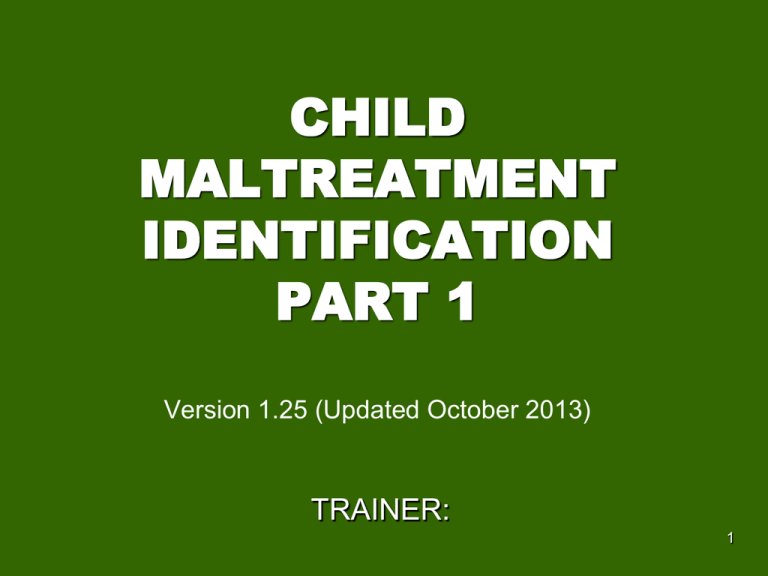
CHILD
MALTREATMENT
IDENTIFICATION
PART 1
Version 1.25 (Updated October 2013)
TRAINER:
1
Welcome
Learning Objectives and Competencies
2
Types of Maltreatment Identified by CPS in 2005
Other
14%
Psych Ab
7%
Sex Ab
9%
Med Negl
2%
Phys Ab
17%
Neglect
63%
899,000 children
3
National numbers…….
In 2005, 899,000 children were victims of
abuse or neglect
For 2005, a nationally estimated 1460
children died of abuse or neglect – a rate
of 1.96 children per 100,000 in the
national population
(US DHHS, Adm. Of Children, Youth & Families, 2005)
4
What is Child Abuse?
Legal definitions:
W&I Code (a-j) – used for
determining juvenile court
jurisdiction
Penal Code (11164 & 11165) –
used for determining if abuse or
neglect occurred
Health and Safety Code
5
Exercise
W & I Code
Code of Ethics
6
Context for Child
Maltreatment
Cultural context
Child rearing standards
Environmental factors
7
COLLABORATION
WHO IS ON YOUR
TEAM?
8
CHILD NEGLECT
9
Why Child Neglect is Important
It’s common in child welfare
Morbidity
Mortality
Our opportunity to intervene
Our responsibility to intervene
The law
10
Child neglect affects
Emotional health
Social development
Cognitive development
Physical health
11
Neglect is # 1
62.8% of victims experience neglect.
If we add medical neglect, this number
goes up to 64.8%!
(U.S. DHHS, Adm. Of Children, Youth & Families, 2005)
Child neglect continues to be the largest
single category of child maltreatment
representing over 58% of the 2.97 million
reports of child maltreatment nationwide.
(Chalk, Gibbons, & Scarupa, 2002)
12
Fatalities due to Child
Maltreatment
~1,460 a year
13
Maltreatment deaths were more
associated with neglect (42.2%) than
with any other type of abuse.
Fatalities resulting from multiple
maltreatment types account for
another 27.3%
Children under age 4 account for
76.6% of all child abuse deaths
Children under 1 account for 42% of
all child abuse fatalities
(U.S. DHHS, Adm. Of Children, Youth & Families. 2005)
14
How we define child
neglect
Shapes our response to the
problem
15
What is it?
Act of omission or commission which
results in minimal sufficient standards
of care of minor(s) not being met.
Basic needs include: adequate food,
clothing, health care, supervision,
protection, education, nurturance, love,
& a home.
16
How do we know what children need?
Scientific evidence
epidemiological data (e.g., infant car seats)
Community standards, values
Not without question
Experience (e.g., history of severe asthma)
Common sense (e.g., hunger)
17
New Knowledge
New Forms of Neglect
exposure to 2nd hand smoke
inadequate treatment of HIV/AIDS
not using car seats/belts
access to a gun
exposure to domestic violence
unsupervised Internet access ?
18
Why do we want to define
child neglect?
To protect children
& improve their well-being
NOT
to blame parents
19
Advantages of a Child-focused,
Broad Definition
Moves us beyond the narrow focus on
parents to consider other contributors
Leads us to consider a broader array of
services, responses
A more constructive, less blaming
approach
Fits with our broad interest in the health,
safety & well-being of children
20
General Neglect
Penal Code
300 (b) Welfare &
Institutions Code
21
SEVERE NEGLECT
Withholding food/water on a prolonged,
willful basis
Severe malnutrition
Non-organic failure to thrive
Failure to provide medical treatment
which will result in permanent and/or
severe illness or death.
Defined in PC 11165.2. (a)
22
Contributors to Neglect
Child
Parent
Neglect
Family
Community
Society
23
Poverty &
Child
Neglect
24
Poverty & neglect
3rd National Incidence Study
Rate of neglect 44 x higher in
families earning < $15,000/ year
(Sedlack & Broadhurst, 1996)
25
Elements of Neglect
Poverty as an issue
BIAS
Poverty itself does not constitute neglect
Other factors: chaos, lack of interpersonal
or job skills, disorganization, apathy, drug
addiction
Others?
26
BEHAVIORAL
INDICATORS OF
NEGLECT
27
Large percentage of neglected children
are developmentally delayed
May present as unresponsive, placid,
dull, uninterested in their surroundings
May appear hungry or tired
May be out of control
May have school/learning issues
28
What does neglect look
like?
Absence
Lack of supervision
“dirty” home
Dental or medical
Psychological
Chronic lice/scabies
FTT
Drug exposure (in utero and beyond)
29
30
What can neglect look
like?
31
Challenges & dilemmas
of neglect
Different
standards, values
and norms re:
child rearing in
different cultural
groups
Marginal child
rearing issues
Ross & Meezan
study
32
Intervention and Treatment
Can Work!
33
Severe Neglect & Resilience
At age 4, excellent catch up in growth &
dev. for children who arrived < 6
months
For those who arrived > 6 months,
good catch up in development
McCarthy General Cognitive Index = 92
(vs. 109 for UK adoptees)
34
EMOTIONAL
ABUSE
35
DEFINITIONS OF
EMOTIONAL ABUSE
PENAL CODE
W & I CODE
36
Challenges with Emotional
Abuse Investigations
Difficult to define and evaluate
Difficult in the Court process
Often combined with other factors of
abuse
Often requires great effort to get
documentation
37
What does it look like?
Rejection
Isolation
Terrorizing
Ignoring/depriving
Corrupting
Humiliating
Confusing
scapegoating
•Setting unrealistic
expectations
•Verbally assaulting
•Putting child in
“double binds
•Parental
unpredictability
•Exposure to DV
38
Impact of Emotional
Abuse on Development
Research findings!
39
PHYSICAL
ABUSE
40
Physical Abuse:
Non-accidental, inflicted injury/trauma
WIC 300 (a) – physical abuse
WIC 300 (e) – severe physical abuse of a
child under 5 years old
Injuries causing death, permanent disfigurement,
significant bleeding, deep bruising, significant
internal or external swelling, fractures,
unconsciousness, prolonged withholding of food.
SUBSTANTIAL RISK of physical harm
41
Physical Abuse in a
Cultural Context
Do our personal
values, experiences
and biases influence
our decisions?
42
Elements to consider in
evaluating abuse:
Location of injury on child’s body
Location/scene of the incident
Type(s) of injury
Severity/extent of current injury/injuries
Frequency of injuries over time
Explanation of injury/injuries
Child’s overall appearance
43
Elements, cont’d
Chronological age of child
Developmental abilities of child
History of unreported maltreatment of these
children by anyone or by these adults of any
other children
History of CWS involvement
Parent/caregiver’s own history of
abuse/neglect
Parent/caregiver substance abuse
44
Characteristics of Child
Typical Triggers
Colic; incessant crying
Awakening at night
Separation anxiety
Normal exploratory behavior
Normal negativism
Poor appetite
Toilet training resistance or accidents
45
Information Gathering –
Parent/Caretaker
People do lie
People do take children to ER after
abuse but there may be a delay in
seeking care
People can love their kids & abuse them
May take truth, change it a little
Changing/contradictory stories very
suspicious
Absence of explanation suspicious
46
Information Gathering,
cont’d
Blaming sibs suspicious
Incident described not consistent
with the developmental abilities of
the child
No witnesses to incident
“Trigger Event” described
“Unknown” perpetrator high risk
47
Information GatheringMedical Personnel
What is the nature of the injury?
Is injury consistent with explanation?
What mechanism would cause this injury?
Spell it – what does it mean?
Put it in writing.
How old is the injury?
Would child be in pain?
Cry out when injured/reaction?
48
TYPES OF
INJURIES
49
Bruises/ Pattern Bruising
Broken Bones/Fractures
Bites
Burns
Contact
Liquid
Immersion
Flame
Internal Injuries
Head Injury
50
Bruises
51
52
53
54
55
56
57
58
59
60
61
62
63
Empathy Exercise
How would you feel…
Child
Parent
Social Worker
Medical Professional
64
Fractures
65
The most common nonaccidental
fractures in children of all ages involve
the skull, the long bones, and the ribs.
In infants, the most common fractures
are in the skull, ribs, and metaphyses.
66
67
68
Twenty per cent of fractures in abused
children involve the femur.
20% of femoral fractures seen in children
ages 2 to 3 are due to abuse
60 % of femoral fractures seen in
children under 1 are due to abuse.
69
There may be a delay in seeking medical
treatment in cases of abuse.
In many abuse cases, minor falls are
blamed for fractures and other serious
injury.
70
Many studies have documented that
minor falls do not usually produce serious
injury.
In one study of 246 children, only 3%
suffered fractures, and none involved the
femur.
71
Pediatric Trauma Center Data
01/00-03/06
All Falls by Major
E-codes
N=2417
By major mechanism
subgroups
72
Pediatric Trauma Center Data
01/00-03/06
All Falls
N=2417
By Mortality Rate
(.008% to .016%*)
*Of the four deaths, two were clearly a
result of a fall from height—one from a
3rd story and one from a 2nd story. The
other two deaths were complex cases
and the etiology was not clear.
73
74
75
Self care
Be prepared, burns are difficult to
look at.
Likewise, this is parallel to your need
to take care of yourself as a child
welfare worker
High burnout if you don’t!
76
Burn Types
Thermal :
Scalds
Flowing/splashing/splattering liquid
Immersion
Contact
Smoldering source
Hot solid
Flame
Radiant
77
Burns represent 10% of all physical
abuse cases.
The peak age of burn victims is 13 to 24
months.
78
Severity Factors
Exposure time
Temperature of heat source
Thickness of skin
Type of Exposure
Heat content/specific heat of source
Heat conductivity within source
Heat emission from surface of source
Coupling media between heat source &
skin
79
Burn Profile Checklist
Attributed to sibling
Unrelated adult
seeking medical
attention
Differing histories
Treatment delay >24
hr
History of injuries
Inappropriate affectparent or child
History incompatible
with injury or
developmental
abilities
Mirror image burns
Localized to
perineum, genitalia,
buttocks
Older than history
Other injuries
80
81
82
Multiple similar
burns
83
Burn Types
Thermal
Contact
84
85
86
87
asphalt
88
Tap water scald burns account for 87%
of inflicted burns.
They are often associated with toilet
training accidents.
89
Reference Temperatures, degrees F
(pain precedes burning!)
101
104-106
109-113
113
120
127
130
140
156
Comfortable Infant Bathing
Hot tub
Painful for adults
2nd degree burn; 6 hours
2nd degree burn; 10 minutes
2nd degree burn; 1 minute
2nd deg; 10 sec (child), 30 sec (adult)
2nd deg; 1 sec (child), 3 sec (adult)
3rd degree burn; 1 second child
90
Calvin and Hobbes
91
Stocking & glove injury:
Foot immersion
92
Donut
diagram
93
Pull down
scalds
Flowing water
runs downhill
94
170o F faucet water
Toddler left in tub.
Parents find
standing, holding
open hot water
handle.
Injury fits history,
but neglect?
95
Clues to Abuse:
Explanation of injury
History
Not consistent with age / ability of
child
Only 1 in 11 10-month-olds tested
could climb into a bathtub
(Allasio & Fischer)
96
Explanation of
injury:
Does it Fit?
Heights/depths/volume
Types handles/ease of
turning
Does water accumulate
with open drain?
How fast/hot as tub
fills?
Bathroom layout
Other basins
97
Other hot fluids: Oil splatter
(Heat content greater than water;
fluid more viscous)
98
99
Cultural Folk Treatments
Moxibustion – Asian medicine practice of
burning herbs to the abdomen
Cao Gio – SE Asian practice of rubbing hot
coins over the back of chest to cure fever, pain,
congestion
Cupping – Mexican/S. American practice of
placing warm cup over the chest to draw out
illness
100
101
102
103
Injuries to the Face,
Ears, Mouth and Neck
104
105
106
107
108
109
Day 2: WELCOME BACK
REVIEW OF PREVIOUS
DAY
AGENDA FOR TODAY
110
Abusive Head Trauma
111
Head injuries are the primary cause of
death in infants in child abuse cases.
Head injury is the leading cause of death
in child abuse cases.
112
Abusive Head Trauma
Head trauma means injury to the face,
scalp, skull, meninges and/or brain as a
result of mechanical force
May be a result of direct impact,
asphyxiation, or shaking
113
Concussion is the most common brain injury
and usually has a brief period of loss of
consciousness with memory loss for the event.
Diffuse axonal injury is the term for a more
severe brain injury. Unconsciousness is
immediate and lasts more than 6 hours.
114
115
116
The skull of the small child is thinner than
that of an adult. The larger head size
and lesser muscle strength results in
more acceleration-deceleration injury.
Skull fractures do not predict the amount
of brain injury – large fractures can be
associated with minor brain injury and
severe brain injury can occur without a
fracture.
117
Skull fractures may be simple or
complex.
Approximately 1/3 of skull fractures in
children under 3 are nonaccidental.
118
Chest Injuries
119
120
Abusive Abdominal
Trauma
Abdominal injuries are the second leading
cause of mortality in child abuse cases.
Average age is older, approximately 2 years.
Boys outnumbered girls 2:1 as victims of this
form of abuse.
Approximately 50% mortality rate, mostly due
to delay in seeking care or misleading
histories at presentation delaying appropriate
diagnosis.
(Kaplan, 2006)
121
Internal Organs include:
Liver
Stomach
Pancreas
Spleen
Kidney
Spinal column
Duodenum
122
Epidemiology
3 most common mechanisms (n=927):
Motor vehicle accidents
Abuse
Falls
61%
16%
13.5%
Mortality 6X greater in abuse than falls
(Trokel et al, 2004)
123
General Features of
Abusive Abdominal Injury
Result from punch, kick, or deceleration
Toddlers and young children at particular
risk
Victims often unable to verbalize
complaints
Children don’t expect and don’t protect
Often no external signs
124
Parents don’t provide an accurate history
May not have immediate symptoms
Where there is an abusive head trauma,
abdominal injury may be overlooked
MORE FATAL THAN ACCIDENTAL
INJURY!
53% to 24% in Ledbetter et al (1988) study
N=156 patients <13 years old with blunt
abdominal injury
(Kaplan, 2006)
125
EMBEDDED
EVALUATION
Time to see what you have learned so far!
126
Life and Death
“We rarely hear about county social workers until they
make a mistake…
Unfortunately we can’t pass laws demanding they
make no mistakes. All we can do is demand the
highest training, and impress upon child protection
officials that the decisions they make are among the
most critically important in our society.”
(Union Tribune July 26, 1998)
127
CLOSURE
THANK YOU AND GOOD LUCK TO YOU
IN YOUR CHILD WELFARE WORK WITH
CHILDREN AND THEIR FAMILIES
128


